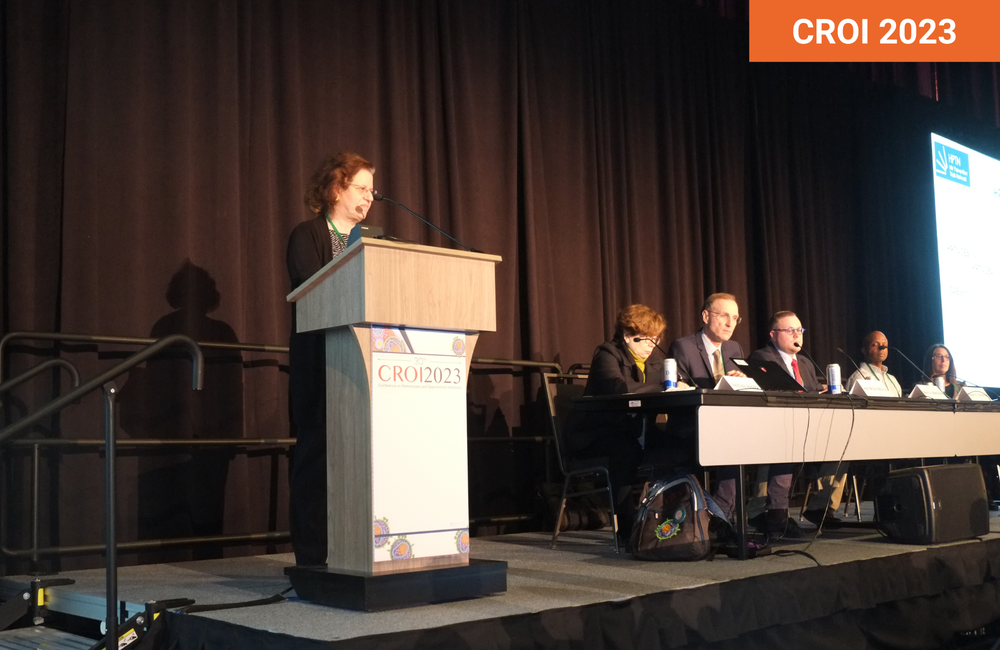
In people who acquire HIV despite taking injectable cabotegravir as PrEP, the course of infection is quite distinct to that seen in people who aren’t taking PrEP, Professor Susan Eshleman of Johns Hopkins University told the 30th Conference on Retroviruses and Opportunistic Infections (CROI) in Seattle last week. People may not feel unwell, viral load is often unusually low and the infection may not be picked up by diagnostic tests for several months, meaning there is a real risk of developing resistance to integrase inhibitors.
Even before any trials of HIV pre-exposure prophylaxis (PrEP) in humans concluded, it was discovered from animal studies that in cases when HIV infection happened despite PrEP, the presence of antiretroviral drugs in the body could lead to a ‘blunted’ infection with a reduced viral load.
In some of the thankfully rare human cases of ‘breakthrough’ HIV infection despite oral PrEP, the normal course of events during infection has followed an unusual sequence, and in some cases test results that were positive have reverted to negative, resulting in delayed diagnosis.
These cases have been so rare until now as to be medical curiosities. But we can expect a few more in people using injectable PrEP. The most recent data from the HPTN 083 study of injectable cabotegravir in gay and bisexual men and transgender women show there are six people who have become infected despite apparently adequate drug levels of cabotegravir.
These breakthrough infections comprise less than 0.3% of the people who have taken cabotegravir in the study. Still, it is five more than the one breakthrough infection (0.06%) seen in the parallel HPTN 084 study, conducted with cisgender women in African countries.
A key problem with these infections is establishing whether they have in fact happened. Eshleman gave as an example an HPTN 083 participant whose case we mentioned in 2021. This man’s test results were so ambiguous that he had difficulty in accepting that he had acquired HIV and even took a month’s worth of PEP at one point.
His HIV infection was first flagged up when a ‘fourth generation’ p24 antigen/antibody (ag/ab) test turned out to be positive at his appointment for his sixth injection. But retrospective testing of stored samples – which had previously been ag/ab tested and had been negative – found a positive result when a sample from nine weeks previously, after his fourth injection, tested positive for HIV RNA. This is not the same as a viral load test; it is a ‘qualitative’ test that only detects the presence of RNA, not its amount. But retesting with an ultrasensitive viral load test that could detect down to 1 copy/ml did find a viral load – of 6 copies.
No other quantitative viral load test within the following 11 months found even a single copy. HIV infection was finally regarded as confirmed when HIV DNA was found in a cell sample, at a level of 5.8 copies per million cells, at the same time as another positive RNA test and a positive ag/ab test, nine months after his initial RNA test. He never had a positive result for the standard confirmatory HIV antibody test.
Altogether in the 48 weeks following that first positive signal of RNA, he had 54 tests using six different types of assays, but only 15 tests yielded a positive result. The four most commonly used assays – the simple antibody test, the ag/ab test, the RNA test, and the viral load test – all reverted more than once during the 48 weeks. ‘Reverted’ means the result switched from positive to negative on retesting.
This is a far more profoundly suppressed infection than those seen in the breakthroughs on oral PrEP, and its indeterminate state lasted much longer. This is partly due to the nature of injectables – they take months to leave the body altogether, during which they are at least partly inhibiting the usual course of infection. (That this man was not a ‘controller’ i.e. doing something exceptional with his immune system to suppress the virus, eventually became clear when, sometime after leaving the trial, he eventually developed a viral load of over 1000 and went on treatment.)
Dubbing this syndrome Long-acting Early Viral Inhibition or LEVI, Professor Eshleman asked how it should be dealt with clinically.
There will only ever be a trickle of these cases, but we will see more if injectables are fully adopted. On the one hand, they probably pose no clinical or public-health threat. People have few if any acute symptoms during this period, their CD4 counts remain high, and their viral loads are far too low to be infectious.
However, there is one possibly significant consequence. At the same time as this man’s infection was finally confirmed with the DNA test, a drug resistance test was taken. This revealed that his HIV had developed two resistance mutations to integrase inhibitors – meaning cabotegravir, dolutegravir, bictegravir and other integrase inhibitors would not work as treatment. His eventual antiretroviral therapy (ART) regimen was based on the protease inhibitor darunavir, but integrase inhibitors are the current mainstay of ART.
The development of resistance in LEVI cases is the rule rather than the exception. Integrase inhibitor resistance arose in 10 of the 18 cases in HPTN 083 where the gap between the last injection and HIV infection was less than six months. So far, there have been no cases of resistance if the gap was longer than that.
Recommending qualitative RNA tests as standard with injectable PrEP would be one solution. This would have detected this man’s HIV nine weeks earlier, and if he had started ART – or even taken just one more HIV drug – at that point, it would have stopped low-level viral replication in the presence of a single drug, which is how you get resistance. This might have preserved integrase inhibitors as a treatment class for him.
On the other hand, LEVI will probably continue to be rare, RNA tests are expensive and would further push up the cost of injectables. Also, positive test results will still need confirmation: as Dr Eshleman said, with so few infections occurring in injectable PrEP users, the chance of a false positive result after a single test is probably higher than a real one.
She added that the HPTN 083 and 084 researchers would be introducing RNA tests in order to decide whether they had a role during the rest of the open-label phase of these pivotal studies.
Eshleman SH et al. The LEVI syndrome: characteristics of early HIV infection with cabotegravir for PrEP. Conference on Retroviruses and Opportunistic Infections, Seattle, abstract 160, 2023.

